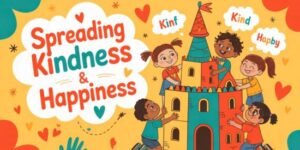Introduction to Kindness Activities For Kids
21 Super Sweet Kindness Activities for Kids That Will Blow Your Mind. Discover simple acts of kindness for students, fun ideas for kids, and activities for school, home, and more.

In our fast-paced world, one of the best gifts we can give our children is kindness. Kindness activities help kids learn to care, share, and make others feel loved.
The joy of kindness activities is that they teach kids to be good. These acts help children build character, empathy, and confidence in showing love. If you’re a parent, teacher, or caregiver, these activities are a great way to show kids how important kindness is.
Want practical Kindness Activities for Kids that make a difference? You’re in the right place.
By doing regular kindness activities, we’re not just raising polite children; we’re helping create caring communities.
What Are Kindness Activities?
Kindness activities for kids are planned ways for them to show love, compassion, and respect. These can be small acts like holding the door for someone, leaving a thank-you note, or helping a friend. Kids learn that by following good examples, they can inspire others.
Some examples of kindness activities are:
- Creative (like art projects with positive messages)
- Interactive (such as empathy-based games)
- Volunteering (helping at a local shelter)
- Family-oriented (like starting a kindness calendar at home)
Why do we need kindness activities for kids today? In a world full of screens and distractions, it’s hard for kids to connect with others. Acts of kindness help them focus on what is truly human—helping and living with heart.
Ideas for kindness activities include:
- Teamwork and cooperation
- Emotional intelligence
- Confidence in doing the right thing
- Positive social connections
Want to make kindness a daily habit? Add one kindness activity to your child’s routine. Just one small act can brighten someone’s day.
Some examples of kindness activities for kids are:
- Sending sweet messages to classmates
- Making gifts for family members
- Cleaning up trash in a local park
- Complimenting a friend
- Donating clothes or toys to someone in need
Acts of Kindness Activities for Kids strengthen both the heart and mind. When done regularly, kindness activities become a lifestyle, not just a project.
Understanding Kindness: A Foundation
Before starting kindness activities, it’s important to discuss why kindness matters. What does it feel like to give kindness? These talks help build a strong emotional foundation for action.
Ask children questions like:
- What does kindness mean to you?
- Have you ever made someone happy in a small way?
- How do you feel when someone is nice to you?
These open-ended questions help kids think about kindness and build their understanding. This makes future kindness activities even more meaningful.
Use drawing, storytelling, or puppet play to create a visual connection. For example, ask them to draw a time they showed kindness.
- Have them practice a kind act through role play.
- Inspirational Activity Ideas: Create a “Kindness Wall” where you can stick a note for every kind act.
- These practices show that kindness starts from within.
Helpful Tip: Catch your child noticing someone being kind, then celebrate together. This helps them become more aware of daily acts of kindness.
Top 21 Mind-blowing Ways to Grow Love in the Heart
1. Storytelling for Kindness
Storytelling is a key kindness activity for kids. Children connect with stories naturally. They learn character names, feel empathy, and understand the world through narratives. This is why reading books about kindness is so powerful.
Choose age-appropriate stories that show characters helping, forgiving, or supporting others. After reading, ask:
- “What nice thing did the character do?”
- “How would you feel if someone treated you like that?”
- “Have you ever done something like that?”
These questions help children think and grow their empathy. This is one of the best kindness activities for students because it combines learning with emotional growth. You could also create a kindness reading corner at home or in the classroom. Use cushions, calming colors, and a shelf of books that inspire kindness.
Some fun storytelling kindness activities include:
- Puppet shows with kind characters
- Writing their own “kindness story”
- Performing short plays about kindness
By turning stories into discussions, you teach kids to learn and practice kindness.
2. Create a Kindness Jar
One fun kindness activity for kids is making a kindness jar! It makes kind actions visible and celebratory. All you need is a clear jar, colorful notes, and pens.
When a child sees or does something kind, they write it down and add it to the jar. Examples include:
- “I helped my brother with his shoes.”
- “I shared my snack with a friend.”
- “I said, ‘thank you’ to my teacher.”
At the end of the week, gather around and read some notes aloud. Celebrate with a small treat or a happy dance! This focuses on kindness ideas for kids that encourage reflection and good habits.
To make it more exciting:
- Use glittery pens or stickers on the notes.
- Assign a “kindness detective” each week.
- Try something like “50 acts = movie night!”
This activity is also great for schools. It’s a simple kindness act that students can do every day in the classroom. The jar becomes a symbol of how small acts can create something beautiful.

3. Paint Kindness Rocks
Looking for a creative kindness activity for kids? Try painting kindness rocks! It’s a fun and simple activity that spreads happiness in unexpected places.
Start by collecting smooth stones during a walk. Have kids decorate them with encouraging words like “You matter,” “Be kind,” and “You’re amazing.” Add smiley faces, hearts, and bright colors. Then go on a “kindness drop-off” mission to place the rocks in:
- Parks
- School gardens
- Neighborhood corners
- Library entrances
This kindness activity combines creativity, nature, and public service. It’s a chance to talk about giving anonymously—doing good without expecting anything in return.
Teachers also enjoy it as a classroom craft project, making it one of the most fun kindness acts for students.
You could even create a “kindness rock garden” where children can find or trade rocks, adding a personal touch to each painted piece.
4. Random Acts of Kindness
A big part of emotional growth is teaching kids that kindness can be spontaneous. That’s why random acts of kindness are so important. These moments of love and care are very powerful.
Here are some ideas for kids to practice kindness:
- Hold the door for someone behind them.
- Give genuine compliments.
- Share toys with others without being asked.
- Help a family member without expecting anything in return.
- Draw a happy picture for someone who seems sad.
You can even create a “Kindness Bingo” game. Kids can cross off squares each time they do something nice. This makes kindness activities fun and rewarding.
Random acts of kindness help students behave better and connect with their peers. Teachers can call out random acts of kindness during class.
Even small gestures can make a big difference like a smile, a hug, or a kind word.
5. Build a Kindness Chain
A kindness chain is a visual symbol of positive actions. It’s a great activity for kids at home or in the classroom.
To create a kindness chain:
- Cut strips of paper.
- When a child does something kind, write it on a strip.
- Link the strips together to form a chain.
Soon, you’ll have a colorful chain around the room. It will remind everyone of their commitment to kindness.
Here are some ideas for what to write on the chain:
- “I helped clean the dishes.”
- “I played with a younger child.”
- “I said sorry when I bumped into someone.”
You can set a goal, like “100 links = kindness party!” This keeps the excitement going. Teachers can also use the chain to show how many acts of kindness are done. This helps create a kind classroom culture.
If kids take this idea home, the whole family can benefit.
6. Kindness Coloring Activities
Coloring is a fun and calming activity. It’s also a great way for kids to practice kindness. Use coloring sheets that show simple acts of kindness, like sharing toys or helping parents.
These activities help kids:
- Imagine what kindness looks like.
- Connect colors with positive feelings.
- Describe what’s happening in the pictures.
You can make a “kindness coloring book” with real-life situations. Include pages like:
- A child feeding a pet.
- Helping clean up a park.
- Giving grandma a hug.
- Saying “thank you” to a delivery worker.
This hands-on activity can be done at home, in schools, or during Sunday school. It’s a creative way to teach kindness during free time or social-emotional lessons.
Tip: Once the pages are done, hang them up as a “Kindness Wall.” This will remind everyone of the love they’ve created through art!
7. Introduce Kindness Tokens
Are you looking for a kindness activity that encourages kids? Try kindness tokens! These are small tokens or cards that reward and recognize acts of kindness.
Here’s how it works:
- Make small “Kindness Tokens” and write “Great Job!” or “You Made Me Smile!” on them.
- Give each child a few tokens to carry.
- When they see someone being kind, like helping a friend or picking up trash, they can give a token!
This encourages kids to notice kindness activities in others. It helps them focus on the good things in their lives.
Kindness tokens work well in class. Teachers can use them to promote a culture of kindness and link them to small rewards or privileges.
This system, used at home and school, shows that kindness is valued and worth repeating. It’s an interactive kindness idea for kids that really sticks.
8. Grow a Kindness Tree
The kindness tree is one of the most visually appealing kindness activities for kids. Kids make paper leaves and write on each one a nice thing they’ve seen or done. The leaves are then pinned to a tree that is hung on a wall or bulletin board.
This activity helps kids:
- Reflect on their actions
- Shine a Light on Kindness
- Follow their progress to watch their efforts “grow” over time
This idea can be applied in numerous scenarios:
- Classrooms (ideal kindness acts for students)
- Living rooms
- Libraries
- Community centers
To enhance the experience:
Use different colored leaves for different categories, such as kindness to friends, family, animals, and the earth.
Establish growth milestones (50 leaves = kindness pizza party!)
This visual reminder prompts regular participation in kind acts and cultivates a realistic sense of pride. And it’s also one of the best kindness activities for bonding and teamwork when you’re working in groups.
9. Write Thank You Notes
Writing notes is a classic way to show appreciation and spread kindness. It’s also a simple but powerful act for kids.
Start with small note cards or colorful paper made for children. Encourage them to write to people who have been kind to them:
- A teacher who made learning fun
- A brother or sister who needed comfort
- A friend who shared lunch
- A neighbor who smiled at them
These handwritten notes teach kids that kindness goes both ways. It’s an important lesson in empathy. This activity is especially meaningful during the holidays, Teacher Appreciation Week, or any lesson about gratitude.
You could set up a weekly “Thank You Thursday,” where each child writes one note. This routine helps build a lasting habit of gratitude.
Words from the heart make a lasting impact. To make it special, have kids deliver or mail their notes.

10. Kindness Challenge Checklist
Want to make kindness fun? Kindness Activities for Kids challenge checklist is a great idea! It turns everyday tasks into fun chances to share love.
Start by creating a printable checklist with items like:
- Tell three people something nice
- Pick up litter at the park
- Share your snack
- Say something nice to a classmate
- Hug your family members
As kids complete each task, they can cross it off the list. This game-like approach makes kindness feel like an adventure. You can create:
- Daily kindness challenges
- Weekly goals with themes (like “Kindness to Animals Week”)
- A family kindness competition
Teachers can make classroom versions, stacking acts of kindness for a big impact. Set goals for the class—if everyone completes five items, they earn a group reward!
These checklists are not just fun; they help make kindness a daily habit. It’s one of the best ideas for kids to connect kindness with their behavior long-term!
11. Practice Giving Compliments
Teaching kids to give sincere compliments is one of the easiest and most powerful kindness activities. When children notice the good in others, they learn empathy and self-awareness.
Encourage them to recognize positive traits, such as:
- A friend’s kindness
- A family member’s helpfulness
- A classmate’s hard work
To make it fun, create a “Compliment Challenge.” Kids can see who can give the most sincere compliments in a day. This can include:
- Thanking a teacher for their hard work
- Complimenting a friend on their creativity
- Recognizing a sibling for sharing toys or helping out
Kids will become more aware of the good around them. They’ll learn that kindness doesn’t just mean actions; it also means noticing and voicing the good in others.
Tip: To encourage them, give small rewards or extra playtime if they offer you compliments during the week!
12. Kindness Scavenger Hunt
What’s better than a scavenger hunt? Kindness Activities for Kids scavenger hunt! This fun activity turns everyday kindness into a game.
Here’s how it works:
Write down acts of Kindness Activities for Kids to find or do. Examples include “Help a friend with homework,” “Pick up trash in the yard,” or “Compliment someone’s outfit.”
Kids can look for these chances throughout the day and cross them off as they happen.
This fun activity helps kids perform kind acts. It encourages teamwork and kindness, making it a great spring activity for students! The goal is to make kindness feel like a fun quest instead of just an idea.
Tip: Keep it fresh with themed hunts, like “Kindness to the Environment” or “Compliment-a-Friend Day”!
13. Draw Pictures of Kindness
Encourage your child to be creative while practicing kindness. Have children draw pictures of Kindness Activities for Kids they’ve seen or done. This helps them understand compassion.
This art activity might include:
- A picture of one friend helping another
- A family member taking care of a pet
- A community member volunteering at a local park
While drawing, kids can think about kindness around them. They learn that small acts can be significant. It’s a great way to promote kindness at school or at home. Plus, it makes a nice display for classrooms or family walls.
Tip: Kids can turn their art into thank-you cards for people who have helped them.
14. Celebrate Kindness Day
One of the best kindness activities for kids is to declare a Kindness Day. Today is a day for forgiving and showing kindness in any way we can.
What acts of kindness can you do on Kindness Day?
- Organize a neighborhood cleanup
- Thank people who make a difference
- Give compliments and positive messages all day
In schools, this can be a day full of kindness activities. You can have “kindness games,” “random acts of kindness” missions, or even a kindness awards ceremony.
Kindness Day lets you pause and appreciate the good works of others. It inspires young minds to feel gratitude and togetherness. We can all feel proud of the kindness we give and receive.
At the end of the day, kids can earn a Kindness Day certificate or badge! 🎉
15. Volunteer Together
One of the best kindness activities for kids is for parents or teachers to volunteer with their children. Giving back to our communities is important. Volunteering helps children learn this value.
Here are some age-appropriate volunteer options:
- Helping at a local food bank
- Cleaning up a park or beach
- Assisting at animal shelters
- Donating clothes and toys to those in need
Read books about helping others and discuss your family’s efforts. Explain why their support matters and how it helps others.
This builds empathy and creates a habit of kindness. It’s a great way for students to include random acts of kindness in their lives.
Families can volunteer together, which strengthens their bonds. It also shows that kindness is best when shared in communities.
Tip: Take pictures throughout the day and create a “Kindness Scrapbook” to remember the great work you did together!
16. Brainstorm Kindness Ideas
This is a great way to get kids involved in their learning. Brainstorm where and how to practice kindness! Kids can create a list of fresh ideas to share with others.
These sessions can include questions like:
- What can we do to help someone smile today?
- How can we lend a hand at home or school?
- How can we empower our community to be kinder?
This encourages kids to think critically and creatively about kindness. It helps them make a positive change in the world! Plus, it’s a fun and educational way to generate ideas for acts of kindness in school.
Pro Tip: Choose the best idea each week and make it a fun competition!
17. Make Donations
Get kids involved in a simple act of kindness: collecting and donating! This fun activity teaches kids about generosity and giving back to the community.
Here’s how to make donations meaningful:
- Have them go through their toys, books, or clothes and pick items that are still in good shape.
- Explain that donating helps someone in need.
- Take them to the local donation center and show how their kindness will help others.
- This activity promotes empathy and shows that even small acts of giving can make a big difference. It teaches kids that everyone can make a difference, no matter their situation.
Tip: Help kids collect and donate at school or in your community with a donation party!
18. Share Meaningful Hugs
Being affectionate is a great form of kindness. Teach children to hug the right way and respect others’ personal space. With permission, a hug is a nice gesture.
Here’s how to include hugs in kindness activities:
- Teach kids to ask before hugging someone.
- Discuss when and where hugging is okay (like a friendly hug after school or a comforting hug for a sibling).
- Differentiate between “friendly” hugs and “family” hugs.
- Teaching about consent and kindness is important. Kindness isn’t just about physical actions. It also means respecting personal space and ensuring emotional safety.
Tip: Make it a “Hug-a-thon” at school where kids can give meaningful hugs (with consent) to celebrate kindness!

19. Play Kindness Bingo
Turn kindness into a fun game with Kindness Bingo! This activity combines fun and learning while encouraging kids to do good deeds.
Create bingo cards with actions like:
- Help a friend with homework
- Compliment someone
- Hold the door for someone
After a day of good deeds, kids can tick off each act of kindness on their bingo card. The goal is to fill the card with as many kind acts as possible.
This playful way to practice kindness helps kids see how small acts can make a big difference. Kindness Bingo keeps kids engaged in practicing kindness at home or in the classroom.
Tip: Offer small prizes or a “Kindness Champion” title for those who complete their bingo cards!
20. Design Kindness Bookmarks
Kindness Activities for Kids bookmarks are popular, easy to make, and a great way to spread positive messages. Kids can create bookmarks with messages or images that inspire others to do good.
Here’s how to set up this activity:
- Give kids materials like paper, markers, and stickers to decorate their bookmarks.
- Invite them to write or draw messages like “Be Kind,” “You Matter,” or “Kindness is Free.”
- These bookmarks can be given to friends, teachers, or family as gifts.
- Creating and sharing kindness bookmarks helps kids express themselves and spread love and positivity.
Tip: Use these bookmarks as handouts during library time or as rewards for acts of kindness done throughout the week.
21. Make a Kindness Catcher
Create a paper fortune teller! The Kindness Catcher has prompts for kind actions kids can do.
Here’s how it works:
- Create a paper fortune teller.
- Write different kinds actions on each flap.
Examples of actions include:
- “Give a compliment.”
- “Help clean up.”
- “Donate an old toy.”
Kids take turns picking a flap and doing the action.
- You can customize the kindness catcher to fit your family, class, or community.
- This fun activity promotes positive behavior and is a favorite among teachers and kids.
- Tip: Use this in your school or home routine to reinforce kindness in daily activities!
Making Kindness a Lifestyle
To make kindness activities for kids effective, kindness should be part of their daily lives. Instead of just one act of kindness, make it a core value in your home or classroom.
Here’s how to bring kindness into everyday life:
- Model kindness: Kids learn from adults. If you show kindness in your actions, children will follow your example.
- Make kindness a celebration: Celebrate acts of kindness often. Give a high-five for a job well done or praise kind gestures. This helps kids understand the value of kindness.
- Talk about kindness: Discuss kindness regularly. Ask kids about their day and how they showed kindness. Share your own stories about being kind.
- Make it fun: Use daily moments, like mealtime or car rides, for kindness activities. Have kids take turns sharing something nice they did or received that day.
- Adding kindness activities to your daily routine creates an environment where kindness feels natural. Kids will start to see kindness as a normal part of life, building a culture of compassion and understanding.
Tip: Create a “Kindness Wall” at home or in the classroom. Kids can write or post Kindness Activities for Kids they’ve seen. This will remind everyone of the power of kindness!
Measuring Impact
It’s important to see how kindness activities affect kids’ behavior and relationships over time. Tracking progress helps maintain these positive changes and shows the long-term benefits. Look for:
- Greater empathy: Preschoolers who practice kindness often develop more empathy. They start to understand how others feel and care about their well-being.
- Teach gentleness in conflict: Learning to handle conflict kindly leads to better communication and problem-solving. This reduces fights and increases cooperation.
- Deeper friendships: Kindness Activities for Kids builds trust and cooperation, which are key to strong friendships. Kids who are kind are more likely to have friends outside the classroom.
- A more positive environment: When kids are nicer to each other, the overall atmosphere improves. This creates a more supportive and loving environment at home, school, or in the community.
- Check progress over time by talking about how kindness affects behavior and relationships. You can also use simple methods like a “kindness journal” or a reward system to track kind acts. Seeing these improvements encourages kids to keep being kind.
Idea: Create a “Kindness Tracker” where each kid can write down every Kindness Activities for Kids they do. This will inspire them and show you how they are improving!
Conclusion
Kindness activities for kids are not just fun; they help build empathy, compassion, and respect. Simple ideas, like storytelling and kindness jars, can greatly shape a child’s heart and mind.
To make kindness a lasting habit, talk about it every day. Show how to treat others well and give examples. When kindness becomes a habit, kids grow up to be more caring, confident, and connected to others.
Small kindness activities for kids, like saying thank you or helping a neighbor, can make a big difference. Start today! Use these kindness activities to help your child develop a kind heart.
Common Questions About Kindness Activities For Kids
Q.1 What are kind things to do for kids?
Kind acts for kids are simple, fun, and meaningful. They help children show love, care, and empathy. Examples include writing thank-you notes, complimenting friends, sharing toys, helping at home, or painting kindness rocks. These activities teach kids to practice compassion every day.
Q.2 What does it mean to be kind?
Being kind means caring for others. Simple acts, like holding the door open or making someone smile, are acts of kindness. These activities are great for home, school, or community events. They help create a more caring world.
Q.3 How can you teach your child kindness?
To teach your child kindness:
- Model kind behavior yourself.
- Do kindness activities at home.
- Celebrate small acts of kindness.
- Talk about feelings and empathy.
- Use books and stories to explore kindness.
Make kindness a part of your daily routine. When kids see kindness every day, they will follow your example.
Q.4 How can we teach acts of kindness?
Teaching acts of kindness is important. Some acts can be simple and consistent. Try a kindness challenge, a kindness tree, or a kindness scavenger hunt. Encourage kids to share their kind actions and reward them with praise or hugs. They will learn that small acts can have a big impact.
Q.5 What is the kindness circle activity?
In a kindness circle, children sit in a circle and pass kind words or tokens to each other. Each child says something nice about the person next to them. This builds confidence, strengthens friendships, and shows the power of words. It’s a heartwarming activity for schools or groups.
Q.6 What’s the greatest simple act of kindness?
A smile is the simplest act of kindness. It costs nothing, is easy to give, and can brighten someone’s day. Other simple ideas include:
- Saying “thank you”
- Picking up litter
- Sharing a snack
- Hugging a friend (with consent)
These small acts show kids that kindness doesn’t have to be grand to make a difference.



